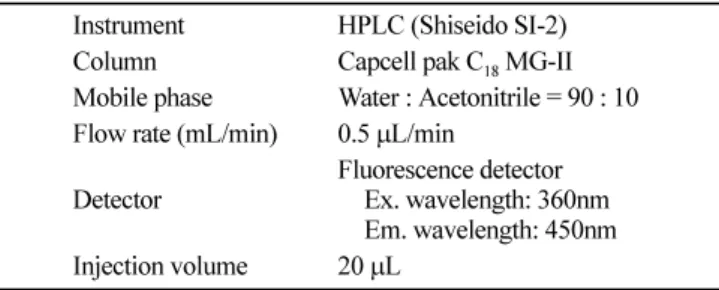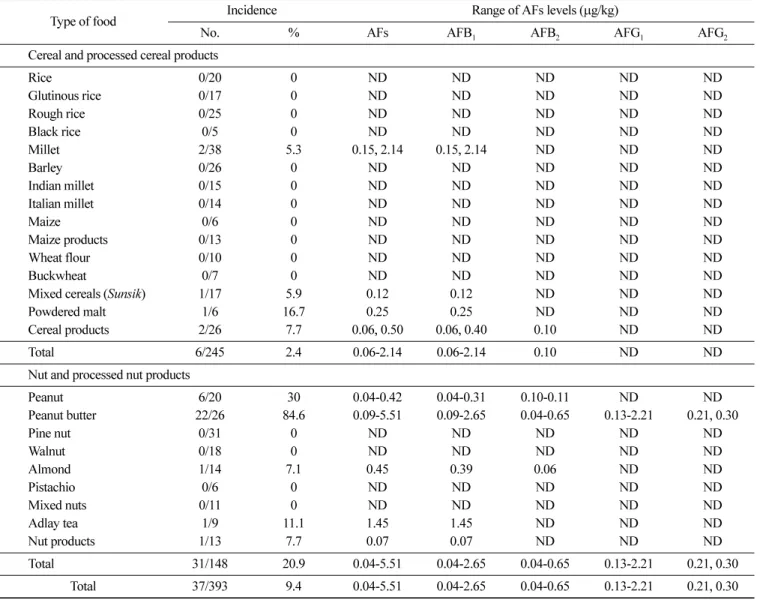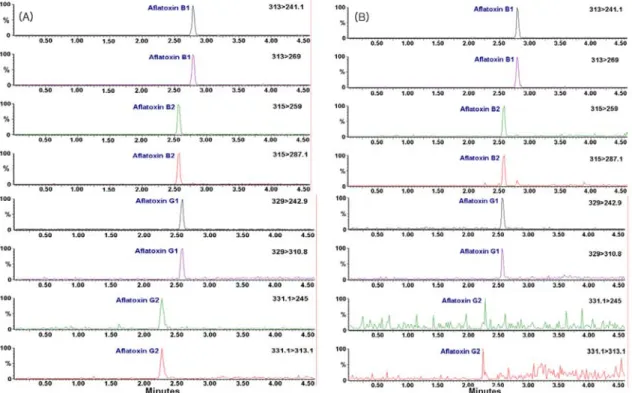KOREAN J. FOOD SCI. TECHNOL. Vol. 39, No. 5, pp. 488~493 (2007)
488
©The Korean Society of Food Science and Technology
HPLC-FLD 및 LC-MS/MS에 의한 식품 중 총아플라톡신 오염실태 조사
장미란·이창희*·조성혜·박준식·권은영·이은진·김소희·김대병부산지방식품의약품안전청 시험분석센터
A Survey of Total Aflatoxins in Food Using High Performance Liquid
Chromatography-Fluorescence Detector (HPLC-FLD) and Liquid
Chromatography Tandem Mass Spectrometry (LC-MS/MS)
Mi-Ran Jang, Chang-Hee Lee*, Sung-Hye Cho, Joon-Shik Park, Eun-Young Kwon,
Eun-Jin Lee, So-Hee Kim, and Dai-Byung Kim
Test & Analytical Center, Busan Regional KFDA
Abstract
A survey for total aflatoxins (aflatoxins B
1, B
2, G
1, and G
2) was conducted on 245 cereals and processed cereal
products, and 148 nuts and processed nut products in Korea, for a total of 393 commercialized samples. The total
aflatoxins were quantified by the immunoaffinity column clean-up method with high performance liquid chromatography
(HPLC) - fluorescence detection (FLD), and were confirmed by liquid chromatography tandem mass spectrometry
(LC-MS/MS). Total aflatoxins (AFs) were detected in 37 samples (9.4% incidence), including 2 millet samples, 1 mixed cereal
(sunsik), 1 powdered malt sample, 2 processed cereal products, 6 peanut samples, 22 peanut butter samples, and 1 sample
each of almonds, adlay tea, and a processed nut product. The contamination levels were 0.04-2.65
µg/kg for aflatoxin B
1,
and 0.04 -5.51
µg/kg for total aflatoxins. Finally, LC-MS/MS analysis of the contaminated samples was conducted to
confirm the detected aflatoxins, and all 37 samples showing aflatoxins by HPLC-FLD were confirmed by LC-MS/MS.
Key words:
aflatoxins, incidence, immunoaffinity column, HPLC-FLD, LC-MS/MS
서
론
아플라톡신(aflatoxin)은 Aspergillus flavus, Asp. parasiticus, Aspergillus nomious등의 Aspergillus속곰팡이에의해생성되는 2 차대사산물로서, 지금까지 20여종의 아플라톡신이알려져있으 며일반적으로발견되는아플라톡신은아플라톡신 B1, B2, G1및 G2이다(1). Aspergillus속곰팡이에의해아플라톡신이 생성되는최 적조건은 온도 28-30oC, 상대습도 80-85%로주로고온·다습한 열대나아열대지방에서가장많이 생성되는것으로보고되어있 으며(2), 특히쌀, 보리등의곡류및땅콩, 피스타치오, 호두등의 견과류와같이탄수화물함량이높은기질에서쉽게생성되는것 으로알려져있다(3). 아플라톡신은 사람및동물에기형발생 및강력한 간독성과 발암성을보이는등치명적인피해를입힐수있는것으로평가 되고 있으며(4), 국제 암연구소(IARC, International Agency for
Research on Cencer)에서는아플라톡신을 Group 1(인체발암물질)
으로정하고 있다(5). 식품 섭취에 의한아플라톡신의 위해성을 피하기위해서는농작물의재배과정, 수확후저장·유통과정에 서곰팡이의 오염 및독소의생성을 억제하거나 생성된독소를 제거해야 한다. 생성된독소를 제거하는 방법의 경우, 지금까지 생성된 독소를제거하기위한다양한연구가진행되고있지만 (6-8), 사실상사전에아플라톡신오염을방지하거나오염된식품의 섭취를 예방하는것을최선의방법으로 제안하고있다(9,10). 따 라서세계각나라별로아플라톡신에대한기준및규격이설정 되어 있으며, 가장 독성이 강한 아플라톡신 B1으로서 관리하는 경우와 총아플라톡신으로서관리하는 경우가있다. 대부분의 유 럽국가에서는아플라톡신 B1및총아플라톡신으로서 기준을설 정하고 있으며, 미국 및 국제규격위원회(CODEX)에서는 총아플 라톡신으로서 기준을 설정하여운용하고 있다(11,12). 이러한 아 플라톡신에 대해총아플라톡신으로서 규격을설정, 또는검토하 고있는국제간의방향을감안하면총아플라톡신에 대한오염실 태를조사할필요성이 있다. 뿐만아니라한국의기후조건이 아 플라톡신 생성에대해비교적덜민감한편이라고는하나, 곡류 를주식으로하고있고상당량의식품및사료원료를수입에의 존하고있어아플라톡신에노출될가능성이높을것으로예상되 므로체계적인모니터링 조사가필요하다(13). 아플라톡신의 분석방법은 일반적으로 형광검출기를 장착한 HPLC 분석법이일반적이며, 아플라톡신의정제를위해
multifunc-tional column을이용하거나 Sep-Pak silica cartridge를사용하는등 의방법이사용되어왔으나, 최근들어 immunoaffinity column을
이용한신속하고 간편한정제법이제시되고있다(14-17).
따라서본연구에서는아플라톡신오염에쉽게노출되는곡류 및견과류와 그가공품에 대해서 immunoaffinity column으로 정
제후 HPLC-FLD로분석하는방법을이용해총아플라톡신의오
*Corresponding author: Chang-Hee Lee, Hazard Substances Analy-sis Team, Test & Analytical Center, Busan Regional Korea Food & Drug Administration, 123-7 Yongdang-dong, Nam-gu, Busan, 608-829, Korea
Tel: 82-51-610-6220 Fax: 82-51-610-6199 E-mail: chang65@hanmail.net
염실태를조사하였다. 또한아플라톡신이 검출되는 시료에대해 서는 LC-MS/MS로확인하였다.
재료 및 방법
시료 2006년 5월부터 9월까지국내유통식품중아플라톡신오염가 능성이높은식품인곡류및곡류가공품, 견과류및견과류가 공품을 대상으로서울, 부산 등전국대도시를 비롯한 10개지 역의대형 할인마트및재래시장 등에서구입하였다. 곡류 및곡 류가공품은쌀, 보리, 기장, 옥수수 등 16품목에대해 245건, 견 과류및 견과류 가공품은 땅콩, 땅콩버터, 잣, 호두 등 9품목에 대해 148건을 구입하여 총 393건의 시료에 대해 총아플라톡신 오염실태를 조사하였다. 가루나 분말 상태의 단순 가공을 거친 시료를제외한모든시료는포장단위로분쇄한후 −20oC의냉동 상태로보관하면서사용하였다. 시약 및 표준 물질아플라톡신 B1, B2, G1, G2표준물질은 Sigma사(St. Louis, MO,
USA)에서구입하여 사용하였으며 추출과 분석에 사용되는
ace-tonitrile, methanol은 HPLC용(Merck Co., Darmstadt, Germany)을 사용하였다. Sodium chloride(Merck Co.), trifluoroacetic acid
(Sigma Co.) 등실험에 사용된모든 시약은 특급및 그이상의
수준을사용하였다.
정제용 칼럼
실험에사용된아플라톡신정제용칼럼은 immunoaffinity column
(AflaTest, Vicam Co., Watertown, MA, USA)을이용하였으며 이 칼럼은 1 mL syringe에아플라톡신에 특이성을 지닌 monoclonal antibody가부착된 sepharose가충진된것으로완충액으로채워져 있으며실온에서 1년간사용이가능하다(18). 시험용액의 조제 시료내아플라톡신의 추출및전처리 과정은 2005년식품의 약품안전청 연구결과 보고서(19)에서 확립한방법을 적용하였다 (Fig. 1). 분석 방법 아플라톡신을 정량분석하기 위해 fluorescence detector가장착 된 HPLC system[Shiseido(SI-2), Tokyo, Japan]을사용하였다. 아 플라톡신분석에 적용된용매및기기조건은 Table 1에나타내었
다. 또한 HPLC-FLD 분석법으로아플라톡신의오염이확인된 시
료는 LC-MS/MS[UPLC ACQUITYTM/Micromass Quattro Premier
XE API triple-quadrupole mass spectrometer(Micromass, Manches-ter, UK)]를이용해확인하였다. 확정실험에적용된용매 및기기 조건은 Table 2와같다.
결과 및 고찰
시료 중 총아플라톡신의 회수율 아플라톡신 B1, B2, G1및 G2 에대한검출한계(limit of detec-tion, LOD)는혼합표준용액을저농도로희석하면서 HPLC-FLD 로분석하여 최소 검출량(signal/noise = 3)을구하는 방법으로 결 정하였으며, 각각 아플라톡신 B1과 B2는 0.01µg/kg, 아플라톡신 G1은 0.15µg/kg, G2는 0.02µg/kg이다. 정량한계(limit of quantifi-cation, LOQ)는각각아플라톡신 B1과 B2는 0.03µg/kg, 아플라톡 신 G1은 0.45µg/kg, G2는 0.06µg/kg이다. 총아플라톡신의 회수율 은아플라톡신이검출되지않은시료중땅콩, 땅콩버터, 미숫가 루, 율무차및밀가루를 선정하여시료에아플라톡신 B1, B2, G1 및 G2 의혼합 표준용액을최종농도 3µg/kg가되도록첨가한후 immunoaffinity column을사용한시료전처리방법과동일하게분 석하여 아플라톡신이 검출되는농도를측정하였다. 회수율실험 결과 아플라톡신 B1은 72.8-100.1%, B2는 80.8-100.5%, G1은 75.8-97.1%, G2는 64.2-92.2%로 비교적양호한 결과를보였으며, 총아플라톡신 중에서아플라톡신 G2는 상대적으로 회수율이 낮은경향을보였는데이는 immunoaffinity column의 antibody의친
화력차이에기인하는것으로추정된다(20).
총 아플라톡신 오염도 조사
국내에서유통중인곡류및곡류가공품(245건)과견과류및
Fig. 1. Flow diagram of sample preparation for analysis of total
aflatoxins in cereals, nuts and their processed products.
Table 1. HPLC conditions for the determination of aflatoxins
Instrument HPLC (Shiseido SI-2) Column Capcell pak C18 MG-II
Mobile phase Water : Acetonitrile = 90 : 10 Flow rate (mL/min) 0.5 µL/min
Detector Fluorescence detectorEx. wavelength: 360nm Em. wavelength: 450nm Injection volume 20 µL
490 한국식품과학회지제 39권제 5호 (2007)
Table 2. LC-MS/MS conditions for the confirmation of aflatoxins
Instrument Parameter Conditions
LC parameter (Waters,
ACQUITYUPLC)
Column ACQUITY UPLCTH BEH C18
(Waters, 2.1×50 mm, 1.7 µm)
Mobile phase 0.1% Formic acid in deionized water 0.1% Formic acid in acetonitrile
Flow rate 0.3 mL/min
Injection volumn 10 µL
MS parameter (Waters, Micromass Quattro Premier XE)
Polarity ESI + Capillary 3.2 kV Cone 33-45 V Source Temp. 120oC Desolvation Temp. 350oC MRM (Multiple Reaction Monitoring)
Aflatoxin B1 313 > 241.1 (Quantification)313 > 269.0 (Confirmatory)
Aflatoxin B2 315 > 259.1 (Quantification)315 > 287.1 (Confirmatory)
Aflatoxin G1 329 > 242.9 (Quantification)329 > 310.8 (Confirmatory)
Aflatoxin G2 331.1 > 245.0 (Quantification)331.1 > 313.1 (Confirmatory)
Table 3. Incidence and range of total aflatoxins(AFs) levels in cereals, nuts, and processed their products
Type of food No. Incidence % AFs AFBRange of AFs levels (µg/kg)
1 AFB2 AFG1 AFG2
Cereal and processed cereal products
Rice 0/20 0 ND ND ND ND ND Glutinous rice 0/17 0 ND ND ND ND ND Rough rice 0/25 0 ND ND ND ND ND Black rice 0/5 0 ND ND ND ND ND Millet 2/38 5.3 0.15, 2.14 0.15, 2.14 ND ND ND Barley 0/26 0 ND ND ND ND ND Indian millet 0/15 0 ND ND ND ND ND Italian millet 0/14 0 ND ND ND ND ND Maize 0/6 0 ND ND ND ND ND Maize products 0/13 0 ND ND ND ND ND Wheat flour 0/10 0 ND ND ND ND ND Buckwheat 0/7 0 ND ND ND ND ND
Mixed cereals (Sunsik) 1/17 5.9 0.12 0.12 ND ND ND
Powdered malt 1/6 16.7 0.25 0.25 ND ND ND
Cereal products 2/26 7.7 0.06, 0.50 0.06, 0.40 0.10 ND ND
Total 6/245 2.4 0.06-2.14 0.06-2.14 0.10 ND ND
Nut and processed nut products
Peanut 6/20 30 0.04-0.42 0.04-0.31 0.10-0.11 ND ND Peanut butter 22/26 84.6 0.09-5.51 0.09-2.65 0.04-0.65 0.13-2.21 0.21, 0.30 Pine nut 0/31 0 ND ND ND ND ND Walnut 0/18 0 ND ND ND ND ND Almond 1/14 7.1 0.45 0.39 0.06 ND ND Pistachio 0/6 0 ND ND ND ND ND Mixed nuts 0/11 0 ND ND ND ND ND Adlay tea 1/9 11.1 1.45 1.45 ND ND ND Nut products 1/13 7.7 0.07 0.07 ND ND ND Total 31/148 20.9 0.04-5.51 0.04-2.65 0.04-0.65 0.13-2.21 0.21, 0.30 Total 37/393 9.4 0.04-5.51 0.04-2.65 0.04-0.65 0.13-2.21 0.21, 0.30
견과류 가공품(148건)을 대상으로 총아플라톡신 오염실태를 조사 한 결과, 총 393건 중 37건(9.4%)에서 아플라톡신 오염이 확인되 었고, 오염수준은 아플라톡신 B1으로서 0.04-2.65 µg/kg, 총아플라 톡신으로서 0.04-5.51 µg/kg 범위로 나타났다(Table 3). 본 연구결 과에서 검출된 아플라톡신의 오염수준은 국내(아플라톡신 B1으로 서, 10 µg/kg 이하) 및 미국(총아플라톡신으로서, 20 µg/kg 이하) 과 CODEX(총아플라톡신으로서, 15 µg/kg 이하)의 기준규격을 초 과하는 것은 없는 것으로 나타났다. 아플라톡신의 검출내역을 살펴보면 곡류에 비해 견과류에서 검 출빈도 및 오염수준이 비교적 높게 나타났다. 특히 땅콩버터와 땅콩에서 각각 84.6%와 30%로 높은 검출빈도를 보였다. 그 중 땅콩버터 2건에서는 총아플라톡신 4종이 모두 검출되었으며, 총 아플라톡신으로서 최고 5.51 µg/kg 검출되었다. 오염된 땅콩버터 에 대한 HPLC-FLD 및 LC-MS/MS 크로마토그램을 각각 Fig. 2 와 Fig. 3에 나타내었다. 견과류에 대한 국내 아플라톡신 모니터 링 연구결과를 살펴보면, Chun 등(21)은 견과류 85건 중 9건(땅 콩 5, 땅콩버터 2건, 피스타치오 1건)에서 아플라톡신이 검출되 었고 볶음 땅콩에서 최고 28.2 µg/kg까지 검출되었다고 보고하였 다. 또한 Park(22)의 연구결과에서는 땅콩 및 땅콩버터 중 21%에 서 아플라톡신 오염이 확인되었으며 오염수준은 1.2-49 µg/kg 범 위로 검출되어, 본 연구 결과는 검출빈도는 높은 편이나 오염수 준은 비교적 낮은 것으로 나타났다. 또한 견과류 중 땅콩 및 땅 콩 가공품이 검출빈도가 높게 나타나는 것은 다른 연구결과와도 유사한 경향을 보였으며, 이러한 경향은 땅콩이 아플라톡신 생성 곰팡이에 가장 오염되기 쉬운 식품 중 하나라는 여러 연구결과 와 일치한다(23-25). 곡류에서는 기장 38건 중 2건에서 아플라톡신 B1이 각각 0.15, 2.14 µg/kg 검출되었고, 곡류 가공품 중에서 미숫가루, 콘프레이 크, 녹두 빈대떡 가루, 엿기름 가루 각 1건씩에서 아플라톡신이 검출되었으며 오염수준은 0.06-0.40 µg/kg 범위로 나타났다. Park 등(26)의 연구결과에서는 2002년 7월-8월 사이에 구입한 쌀 시료 88건 중 5건에서 1.8-7.3 µg/kg 수준의 아플라톡신이 검출되었고,
Fig. 2. HPLC-FLD chromatograms of aflatoxin B
1, B
2, G
1, and
G
2at 3
µg/kg (A) and contaminated with aflatoxins in peanut
butter containing aflatoxin B
1(0.81
µg/kg), B
2(0.23
µg/kg), G
1(0.57
µg/kg), and G
2(0.21
µg/kg) (B).
492 한국식품과학회지제 39권제 5호 (2007) 보리 및보리가공품 62건 중 4건에서 8-11µg/kg 검출되었으며, 옥수수및가공품 65건중 4건에서 8-10µg/kg 검출되었다. 또한 Oh 등(27)은쌀, 보리등곡류 97건중기장 1건에서만 0.99µg/ kg 검출된 것으로보고하여, 본연구에서는 이와유사하거나비 교적낮은검출수준을보였다. 이와 같이아플라톡신에 대한오 염도조사결과가조금씩다른경향을보이는것은시료의수집 시기및장소, 생산년도 등의저장조건 또는유통경로의차이에 따라오염수준이 다를수있기 때문인것으로 판단된다. 또한외 국의곡류 및견과류에대한 아플라톡신에 대한모니터링 연구 결과와비교하면, Sugita-Konishi 등(28)은일본에서 유통중인견 과류및곡류에 대한오염도 조사결과에서땅콩버터 10건에서 아플라톡신 B1으로서 최고 2.59µg/kg 검출되었으며, 곡류에서는 검출되지않았다고보고하여본연구결과와유사한수준을보였 다. 또한 Abdulkadar 등(29)은땅콩에서 0.17-2.13µg/kg, 땅콩버터 에서 0.32-13.26µg/kg 검출되었다고 보고하였으며 Thuvander 등 (30)은견과류중땅콩가공품, Brazil Nuts, 피스타치오등에서아 플라톡신이최고 2,200µg/kg까지검출되었다고 보고하였다. 외국 의사례는 해당국가에따라 기후조건이나 재배환경 등이다르 기때문에 직접적인비교를할수는없으나, 우리나라의 경우곡 류및견과류에 대한아플라톡신의 오염정도가 비교적 낮은것 으로 나타났다. 그러나 우리나라는 곡류를 주식으로 하고 있기 때문에검출빈도가낮고오염수준이미량이라하더라도잠재적 으로아플라톡신오염에노출될가능성이높은것으로볼수있 다. 또한 37건의오염된시료중 24건에서아플라톡신 B1외에도 B2, G1또는 G2도검출되어총아플라톡신에 대한안전성검토가 이루어져야할것으로판단되며, 이에대한충분한검토를위해 다양한 품목에서 지속적으로 총아플라톡신에대한 오염실태 조 사가이루어져야할것으로판단된다.
요
약
국내유통중인곡류, 견과류및그가공품총 25품목, 393건의 시료에대해 immunoaffinity column 정제방법을이용하여총아플 라톡신오염실태를조사하였으며, 그결과 곡류및곡류가공품 6 건, 견과류및견과류가공품 37건에서아플라톡신 오염이확인 되었으며오염수준은 아플라톡신 B1으로서 0.04-2.65µg/kg, 총아 플라톡신으로서 0.04-5.51µg/kg 범위로나타났다. Immunoaffinity column 정제를거쳐 HPLC-FLD로분석한결과아플라톡신이검 출된 시료에 대해서 LC-MS/MS로 확인하였으며, 그 결과 모두 아플라톡신으로확인되었다. 본연구결과에서 나타난곡류 및견 과류에대한아플라톡신 검출빈도및오염수준은국내, 외연구 결과와유사하거나비교적낮게나타났으며국내아플라톡신기 준및미국, CODEX에서설정된기준규격 이하로검출되었다.문
헌
1. Iamanaka BT, de Menezes HC, Vicente E, Leite RSF, Taniwaki MH. Aflatoxigenic fungi and aflatoxins occurrence in sultanas and dried figs commercialized in Brazil. Food Control 18: 454-457 (2007).
2. Rustom IYS. Aflatoxin in food and feed: Occurrence, legislation, and inactivation by physical methods. Food Chem. 59: 57-67 (1997).
3. Blesa J, Soriano JM, Moltó JC, Mañes J. Limited survey for the presence of aflatoxins in foods from local markets and supermar-kets in Valencia, Spain. Food Addit. Contam. 21: 165-171 (2004). 4. Bae SI, Kwak BY, Park YK, Kim YH, Shon DH. Survey of
afla-toxin B1 in domestic doenjang and kochujang determined by
enzyme linked-immunosorbent assay. J. Food Hyg. Saf. 18: 95-100 (2003)
5. IARC monographs on the evaluation of carcinogenic risks to humans. Agents reviewed by the IARC monographs. Volumes 1-97 Available from: http://monographs.iarc.fr/ENG/Classification/ crthallalph.php Accessed Aug. 13, (2007)
6. Lee SE, Campbell BC, Molyneux RJ, Hasegawa S, Lee HS. Inhibitory effects of naturally occurring compounds on aflatoxin B1 biotransformation. J. Agr. Food Chem. 49: 5171-5177 (2001)
7. Das C, Mishrain HN. In vitro degradation of aflatoxin B1 by
horse radish peroxidase. Food Chem. 68: 309-313 (2000)
8. Buser MD, Abbas HK. Effects of extrusion temperature and dwell time on aflatoxin levels in cottonseed. J. Agr. Food Chem. 50: 2556-2559 (2002)
9. Yeo HJ, Kim JG. Effects of cooking and processing on the reduc-tion of aflatoxin content in corn. J. Food Hyg. Saf. 18: 87-93 (2003)
10. Semple RL, Frio AS, Hicks PA and Lozare JV. Mycotoxin pre-vention and control in foodgrains. A collaborative publication of the UNDP/FAO Regional Network Inter-Country Cooperation on Preharvest Technology and Quality Control of Foodgrains (REG-NET) and the ASEAN Grain Postharvest Programme. Available from: http://www.fao.org/docrep/x5036e/x5036E00.htm Accessed Aug. 16, (2007)
11. Creppy EE. Update of survey, regulation, and toxic effects of mycotoxins in Europe. Toxicol. Lett. 127: 19-28 (2002)
12. Worldwide regulations for mycotoxins in food and feed in 2003. FAO Food and nutition paper 81. Food and Agriculture Organiza-tion of the United NaOrganiza-tions Rome 2004. Available from: http:// www.fao.org/docrep/007/y5499e/y5499e00.htm Accessed Aug. 16, (2007)
13. Hwang JH, Chun HS, Lee KG. Aflatoxins in food-Analytical methods and reduction of toxicity by physicochemical processes. J. Korean Soc. Appl. Bio. Chem. 47: 1-16 (2004)
14. Akiyama H, Goda Y, Tanaka T, Toyoda M. Determination of aflatoxin B1, B2, G1, G2 in spices using a multifunctional column
clean-up. J. Chromatogr. A 932: 153-157 (2001)
15. Park JW, Kim EK, Shon DH, Kim YB. Natural co-occurrence of aflatoxin B1, fumonisin B1, and ochratoxin A in barley and corn
foods from Korea. Food Addit. Contam. 19: 1073-1080 (2002) 16. Giray B, Girgin G, Engin AB, Aydin S, Sahin G. Aflatoxin levels
in wheat samples consumed in some regions of Turkey. Food Control 18: 23-29 (2007)
17. Abdulkadar AHW, Al-Ali AA, Al-Kildi AM, Al-Jedah JH. Myc-otoxins in food products available in Qatar. Food Control 15: 543-548 (2004)
18. Kim MH. Comparison of methods for determination of aflatoxins in food products. J. Food Hyg. Saf. 11: 149-157 (1996)
19. Lee JO, Oh KS, Sho YS, Park SS, Suh JH, Choi WJ, Lee BH, Woo GJ. A survey of total aflatoxin in foods. Annu. Rep. KFDA 9. p. 148. Korea Food & Drug Administration, Seoul, Korea (2005)
20. Oh KS, Suh JH, Park SS, Sho YS, Choi WJ, An YS, Lee JO, Woo GJ. Advanced in the analysis of total aflatoxin in foods. J. Food Hyg. Saf. 21: 76-81 (2006)
21. Chun HS, Kim HJ, Ok HE, Hwang JB, Chung DH. Determina-tion of aflatoxin levels in nuts and their products consumed in South Korea. Food Chem. 102: 385-391 (2007)
22. Park JW. Analysis of peanut and peanut butter retailed in Korea for aflatoxin B1. Korean J. Food Sci. Technol. 38: 309-312
(2006)
23. Chan D, MacDonald SJ, Boughtflower V, Brereton P. Simulta-neous determination of aflatoxins and ochratoxin A in food using a fully automated immunoaffinity column clean-up and liquid chromatography–fluorescence detection. J. Chromatogr. A 1059: 13-16 (2004)
24. Escobar A, Regueiro OS. Determination of aflatoxin B1 in food
and feedstuffs in Cuba (1990 through 1996) using an immunoen-zymatic reagent kit (Aflacen). J. Food Protect. 65: 219-221 (2002)
cyclo-piazonic acid associated with peanut retailing in Botswana. J. Food Protect. 67: 96-102 (2004)
26. Park JW, Kim EK, Kim YB. Estimation of the daily exposure of Koreans to aflatoxin B1 through food consumption. Food Addit.
Contam. 21: 70-75 (2004)
27. Oh KS, Suh JH, Sho YS, Park SS, Choi WJ, JO Lee, Kim HY, Woo GJ. Exposure assessment of total aflatoxin in foods. Korean J. Food Sci. Technol. 39: 25-28 (2007)
28. Sugita-Konishi Y, Nakajima M, Tabata S, Ishikuro E, Tanaka T,
Norizuki H, Itoh Y, Aoyama K, Fujita K, Kai S, Kumagai S. Occurrence of aflatoxins, ochratoxin A, and fumonisins in retail foods in Japan. J. Food Protect. 69: 1365-1370 (2006)
29. Abdulkadar AHW, Al-Ali A, Al-Jedah J. Aflatoxin contamination in edible nuts imported in Qatar. Food Control 11: 157-160 (2000)
30. Thuvander A, Möller T, Barbieri HE, Jansson A, Salomonsson AC, Olsen M. Dietary intake of some important mycotoxins by the Swedish population. Food Addit. Contam. 18: 696-706 (2001)


